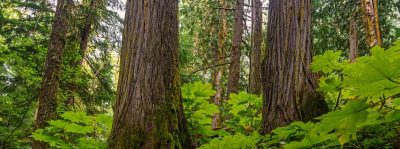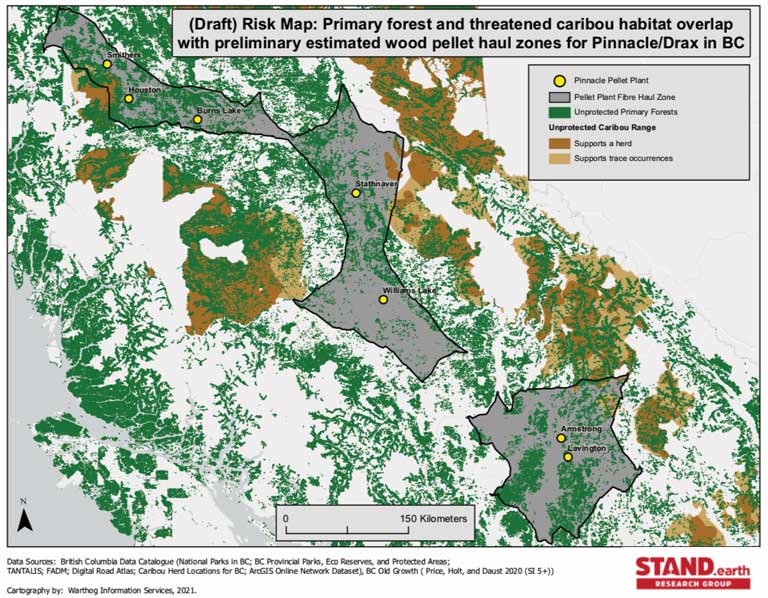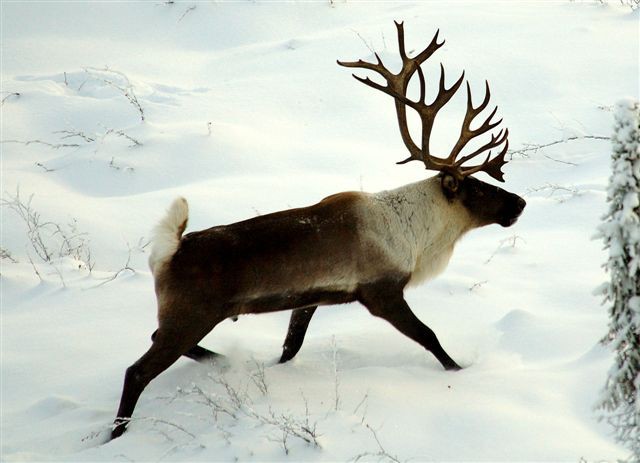With British Columbia’s Last Old-growth at Risk, Government Falters: Critics

All Global Research articles can be read in 51 languages by activating the “Translate Website” drop down menu on the top banner of our home page (Desktop version).
***
For old-growth forest advocates in British Columbia last year, it sounded like a political turning point. In the race to preserve what’s left of some of the rarest, most ancient tall trees and endangered ecosystems in North America, the provincial government promised action.
“In early September, we moved to protect nearly 353,000 hectares [1,363 square miles] of old-growth forests,” said John Horgan, BC’s premier and head of the New Democratic Party (NDP) majority government, as he spoke last October. “But that’s just the beginning. Many of our old-growth stands are worth more standing up than they ever could be cut down, especially… acknowledge[ing] the broader benefits for communities and the environment.”
Horgan went further. He announced that the NDP had accepted in its entirety the recommendations of a 71-page NDP-commissioned 2020 report, a detailed land-use plan created by foresters Garry Merkel and Al Gorley, explaining why and how to preserve BC’s vanishing coastal and interior primary and old-growth forests.
All 14 report recommendations were agreed to, including an immediate deferral of logging “in old forests where ecosystems are at very high or near-term risk of irreversible biodiversity loss.”
Horgan’s proclamation and the report’s adoption were seen as a bold sea change for BC — a Canadian province that has long favored the economics of forestry over conservation.

Biologically productive old-growth forests are complex ecosystems. From the 2020 report A New Future for Old Forests: “Old forests meld light and dark; their structural complexity can include large old living trees, large standing dead snags, long downed logs, a multi-layered canopy, horizontal patchiness with canopy gaps that allow understory growth, and hummocky micro-topography.” Image by Jakob Dulisse.
From bold pledges to ‘Talk and log’
Barely six months later, once-hopeful forest advocates are calling Horgan’s statements “talk and log.”
Nearly half the area he said had been protected remains open to logging for timber and wood pellet-for-energy manufacture. Much of the rest doesn’t qualify as the intact, biodiverse forests chosen for logging deferrals by the 2020 report. Meanwhile, the timber and forest biomass industries are moving ahead fast to procure and cut new forest tracts.
“I see BC slowly slipping away from this brighter future that was promised,” said Tegan Hansen, a forest campaigner with the environmental group Stand.earth. “Instead, we’re doubling down on a forestry paradigm that is leveling primary forests and further degrading high-risk species and ecosystems.”
Researchers and policymakers worldwide acknowledge that without aggressive regulation at regional and national levels, the environmental protections needed to save forests, curb climate change and protect biodiversity will not likely occur.
But as with the Kyoto Protocol, Paris Climate Agreement, and the 25 past U.N. climate conferences, soaring government rhetoric is rarely transformed into significant action, while business as usual continues to warm the planet.
In interviews with leading BC environmental and political figures, each grapples here with the dire implications for their province and the world if sustainable forest management fails there.

Low productivity forests like this one don’t have anywhere near the same capacity for sequestering carbon as do old-growth forests. Image by TJ Watt for Ancient Forest Alliance.
‘We will run out of old-growth’
A year ago, forest ecologist Karen Price and colleagues Rachel Holt and Dave Daust produced a different, but alarming, report based on BC provincial data. While the government asserted that 23% of the province’s standing forests were old-growth (51,000 square miles), in reality less than 1% (1,544 square miles) existed as the towering, centuries-old red cedar and western hemlock inland rainforests that define biodiverse old-growth.
In the year since, many of those tall trees have been lost to timbering.
“If the NDP doesn’t act, we will run out of old-growth in five to 10 years,” Price told Mongabay. “We need the deferrals [Horgan promised] so that we can have meaningful land-use discussions and planning while there is still old-growth left to make decisions about.”
However, Price says she’s been told repeatedly by the government that saving trees takes time. The 2020 Merkel/Gorley report recommended, for example, that some 200 First Nation tribes in BC be consulted about land they want protected before regulations are written. Such talks are ongoing, says the NDP.
Except that, “Across BC, there are First Nations who have already requested moratoria of harvesting old-growth in their territory,” Price said. “There are some [Indigenous] nations who have areas mapped out ready to share with the government. The forestry industry has taken those maps and it appears [to be] prioritizing logging in those places now.… And the government is doing nothing to protect this old-growth land.”
Conservation North, a forest-protection advocacy group, put together an interactive map called: Seeing Red: BC’s last primary forests. The province-wide, full-color map illustrates the extent of deforestation in British Columbia as well as the smaller areas where primary and old-growth forests remain.
Price and other leading environmentalists say they are exasperated by the government’s lack of action, noting that grim deforestation field reports, letters to provincial forestry ministers, and anguished public statements only receive vague official NDP responses.
“We are frustrated because the stakes are so high,” Price said. “This is a government that purportedly listens to science. There are good people in the NDP [re-elected by historic margins in November]. But as we continue to log in BC — some 200,000 hectares per year (772 square miles) — a lot of that is old-growth.
“If we don’t keep those standing, Canada is not going to meet its carbon-reduction goals under the Paris Agreement. We need to maintain our inland and coastal rainforests. It’s critical for working toward Canada’s and the world’s climate mitigation.”

Forest activists fear that British Columbia’s last old-growth forests could be reduced to wood pellets burned abroad for energy. Image found on Flickr.
Industry versus nature?
Garry Merkel told Mongabay he was not surprised that his, and fellow forester Al Gorley’s, groundbreaking 2020 report, A New Future for Old Forests, was embraced by BC Premier Horgan. Afterall, the pair was hand-selected by the NDP, spent months gathering stakeholder input, and enjoy a reputation for non-partisan environmentalism.
Aside from their immediate old-growth logging deferral recommendation, he and Gorley called for a radical shift in policy in a province whose economy was built on logging and timber exports. Their recommendation: nature must come before industry. As such, they wrote, “conservation of ecosystem health and biodiversity of BC’s forests [becomes] an overarching priority,” with laws enacted to establish protection over timber interests.
In British Columbia, current laws seem to protect forests, wildlife, visual impacts and wilderness recreation. But there’s a catch: none of that can reduce the “Annual Allowable Cut” of timber by more than 10%. According to forest activists, the actions of Horgan and the NDP show that BC’s generations-old mantra still holds: forestry industry first; nature a distant second.
“We need to fundamentally change our paradigm to manage for ecosystem health and health of the land,” Merkel said. “We cannot continue to head down this road of managing for [timber] resources subject to constraints. That model doesn’t work for anybody.
“Our job was to make recommendations on how to take a much more scientific approach to managing old-growth in BC,” he added. “It’s [now] the government’s job to figure out the balance.”
Merkel still believes the NDP is doing just that “as fast as they possibly can.” He agrees however, that logging deferrals haven’t been put in place as promised. He said he believes it will take two to three years to enact the new regulations the NDP adopted, and that imperiled old-growth forests will likely be lost in the meantime.
Others doubt whether the NDP can shift the province’s historical forestry-centric model. They note that while the industry is down to just 3% of provincial GDP, it still holds political clout.
That too needs to change, Merkel said. “We built BC on the back of the forest industry; it’s a part of our core culture.” In a once forested province four times bigger than California, it must have seemed once that trees existed in endless supply. But “They’re not endless. That’s the direction we’re heading — [toward] a more sustainable model for everyone.”

Pinnacle Renewable Energy’s Strathnaver facility which produces wood pellets exported and burned to make electricity. Wood when burned releases more carbon dioxide per unit of electricity produced than coal or gas, and a newly planted sapling replacing a mature tree requires several decades to reabsorb the carbon dioxide emitted by burning — time the world doesn’t have as it rushes to reduce greenhouse gas emissions. Image by Mary Booth.
BC forestry minister speaks
Mongabay requested an interview with Katrine Conroy, the NDP’s forestry minister. She declined through a spokesperson, but offered a statement which was unresponsive to specific questions.
“We want to make sure people can appreciate old-growth trees for years to come, while supporting a sustainable forest sector for workers and communities,” Conroy wrote. “In September, we worked collaboratively with First Nations on a government-to-government basis and protected old-growth in nine different areas that were at high-risk across BC. This was an important step in acting on the top two recommendations from the [Merkel/Gorley] old-growth report.
“We know there is much more work to do. To get this right, we will follow the advice of the old-growth report and fully engage Indigenous leaders, industry, workers, communities and environmental groups to find the right way forward for old-growth forests in BC.”
Price, the forest ecologist, called Conroy’s statement an example of “talk and log.” Published reports note that logging is now taking place in all of those “nine different areas.” Critically important Merkel/Gorley recommendations have not yet been implemented, said Price.
In an op-ed co-authored for the Victoria Sun in October, Price estimated that the amount of BC’s majestic old-growth newly protected from logging is just 14 square miles scattered from coast to interior.

Pinnacle Renewable Energy operates seven inland pellet mills in BC and is the province’s largest pellet producer. Pictured here is its Burns Lake facility. In February, Drax Group of the United Kingdom announced it was acquiring Pinnacle, helping assure the gigantic power plant its wood supply. Image by Google Earth, CNES-Airbus 2021.
The green of money versus the green of conservation
Forestry expert Kevin Kriese chairs BC’s Forest Practices Board. He’s witnessed decades of BC policy that accelerated logging across the province.
Of the NDP he said:
“I think the government made a political commitment and is not sure what it committed to. You read the Merkel/Gorley report, there’s a lot of room for interpretation. Some think it’s obvious; others see the devil in the details. Regardless, the government needs to commit significant resources to carry out this plan, and right now, the money isn’t there.”
That economic imbalance between forestry and conservation is being partly driven by the wood pellet industry, which experts say accounts for 10% of BC’s wood consumption in either lumber waste, diseased trees and whole trees less valuable as timber, but valuable as standing forests, carbon sinks and biodiversity havens. The BC wood pellet export industry has created several hundred jobs, even as thousands of saw mill jobs have been lost.
And that industry appears to be digging in for the long haul. In February, Drax Group of the United Kingdom announced it was acquiring BC’s largest pellet producer, Pinnacle Renewable Energy and its seven inland pellet mills.
Drax provides up to 12% of the U.K.’s energy at the world’s largest pellet-burning plant — a facility the U.K. claims to be carbon neutral, though science has repeatedly shown that to be false. Drax is also a major manufacturer of pellets in the U.S. Southeast for export. One stated company goal: securing supply for a growing market to Japan for wood pellets for energy.


Canadian caribou thrive in old-growth forests. Image courtesy of the Canadian government / © John A. Nagy.
Kriese sees a political conundrum for the NDP, as it embraces two goals at cross purposes — continued forestry industry support and greater forest protection.
For “Those with a strong agenda on conservation, every stick of old-growth matters,” he said. “But there are those who still think we can harvest some old-growth and still conserve some… This is the challenge [inside the NDP].”
The meteoric growth of the wood pellet industry complicates this conundrum, especially as lumber waste declines and whole trees are harvested more for pellets. But today, pressure on tall, old-growth forests still comes mostly from the timber industry economy as the government seeks to protect a shrinking number of rural community jobs.
“We have committed to something the bureaucracy has never done before — the balance shift between conservation and logging,” Kriese said. “What shade of green will it be? It’s going to take a while.”
One crucial question remains as the clock ticks, a question common to all regions and nations: is there the political will to make decisions that benefit a dangerously warming planet first, while coping later with the economic impact?

Anzac Valley clearcuts in British Columbia’s boreal rainforest. Image by Taylor Roades courtesy of Stand.earth.
Fairy Creek: ‘the litmus test’
Sonia Furstenau has demonstrated since she entered local politics in 2014 that she has the political will. But now as leader of the Green Party, with just two seats in BC’s parliament, she doesn’t have the power.
“I know what they say [in the NDP], but I don’t know what this government’s long-term vision is for forestry,” Furstenau told Mongabay. “They are adhering to the status quo that is giving us the same outcomes we’ve had for decades.
“I was on the finance committee a few years ago. I spent a lot of time in small planes flying over the province. When you fly over British Columbia, it is a landscape of devastation. It’s heart-wrenching to see it from the sky, just how little intact forest there is left.”
A steady parade of BC governments has practiced a policy of deforestation on “crown land,” she said. “It is owned by the public. It is a public asset. And the NDP is allowing for decisions to be made about this public asset while not adhering to the promises it made.”
As such, standing forest and forestry continue to collide. Logging is allowed within a mere 100 meters of the pristine West Coast Trail on Vancouver Island. A proposed wood pellet mill in Fort Nelson threatens the largest remaining tract of primary and old-growth forest in BC’s northern interior.
And at Fairy Creek — only 1,200 hectares (4.6 square miles) — the last intact watershed of old-growth forest on southern Vancouver Island is at risk. Protesters blocked roads there for months to keep a logging company out, but the BC Supreme Court ordered demonstrators removed in early April.
Furstenau likens the massive, centuries-old western red cedars and yellow cedars at Fairy Creek to the world’s endangered megafauna — rhinos, elephants and lions.
This video features a contentious exchange during a session of the British Columbia Parliament on March 25, as Green Party leader Sonia Furstenau asks Forestry Minister Katrine Conroy if the NDP government intends to keep loggers away from Fairy Creek, the last intact watershed of old-growth forest remaining on southern Vancouver Island.
“We recognize the role, the rareness and the value that those large animals have in their African ecosystems,” she said. “It’s the same here in BC. These are the last giants. And to just drop them for timber or wood pellets is heartbreaking and so short-sighted.”
Fairy Creek is on the front line, say activists, of the sort of majestic old-growth forest desperately in need of immediate protection as described by the Merkel/Gorley report. But when asked by Mongabay if the NDP would protect it, Forestry Minister Conroy declined to respond.
“I went down to Fairy Creek a few weeks ago,” Furstenau said. “To get there, you have to drive through clear cuts all around. And then you get to that intact forest, and you are altered by being in a place like that. You are surrounded by an abundance of life. And to get there, you have to drive through this landscape of death.”

British Columbia’s remaining old-growth forests aren’t only valuable for the carbon storage they provide; they are also cherished for their uniqueness, the biodiversity they harbor, and the awe they inspire. Image by Jakob Dulisse.
Furstenau understands economic realities. She realizes logging and conservation in BC must co-exist. But she said,
“If we want to protect jobs, the way to get there is not to cut down as much timber as possible in the shortest amount of time.… If you want jobs and sustainability, short-term profits can’t come before all else.”
The NDP, with its unchallenged provincial parliamentary majority, could intervene at any time in Fairy Creek, Furstenau stressed. It could, if it chose, buy back the logging permits and protect these ancient endangered trees.
“They have the power to do that,” Furstenau said. “They are the government. This is crown land. So this is the litmus test. This will show if they actually mean what they say. If they do not act to protect all of Fairy Creek, then their words are meaningless.”
*
Note to readers: please click the share buttons above or below. Forward this article to your email lists. Crosspost on your blog site, internet forums. etc.
Justin Catanoso, a regular contributor to Mongabay, is a professor of journalism at Wake Forest University in North Carolina. Follow him on Twitter @jcatanoso
Featured image: Ancient old-growth forest near Prince George, British Columbia. Image courtesy of Stand.earth.

